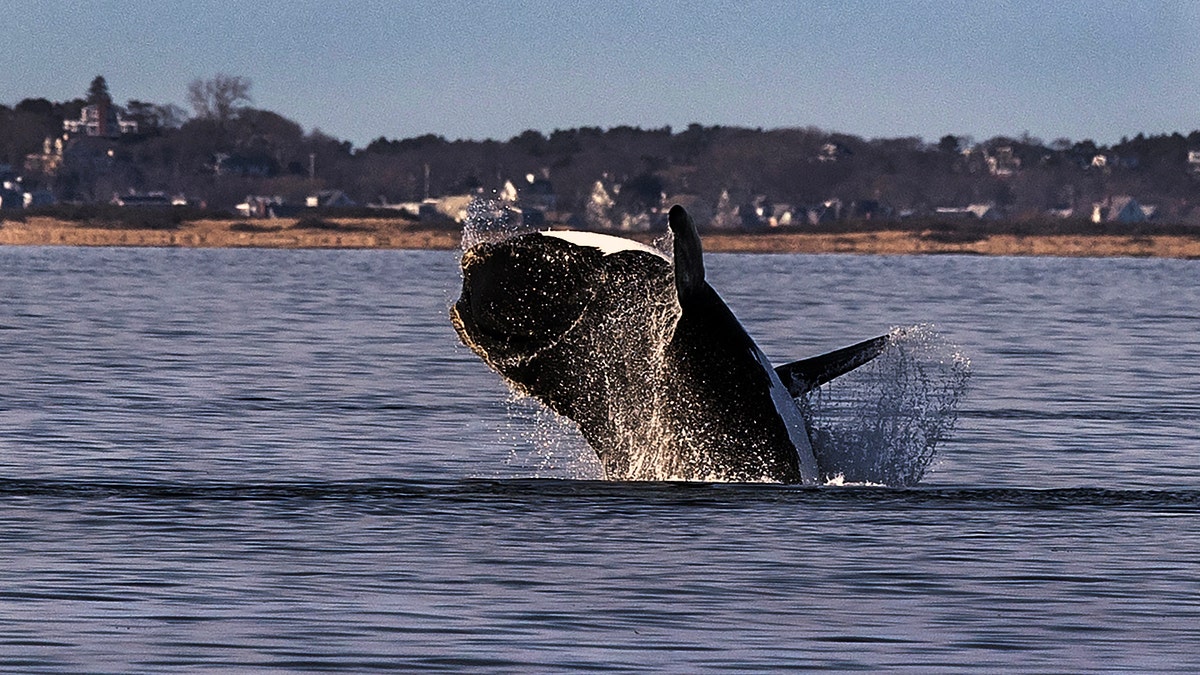We support our Publishers and Content Creators. You can view this story on their website by CLICKING HERE.
Maine fishermen aim to sink Biden’s offshore wind farm plan
FOX Business’ Lydia Hu reports on President Biden’s wind farm plan opposed by Maine’s fisheries. New England Fishermen’s Stewardship founder Jerry Leeman explains how the plan poses a risk to marine life and the industry, saying ‘it’ll cripple us.’
A group of Nantucket, Massachusetts, residents are appealing to the U.S. Supreme Court in their challenge to the industrialization of parts of the Atlantic Ocean, where they say offshore wind farms – developed with the blessing of the federal government – are putting an endangered whale species at risk.
The group, Nantucket Residents Against Turbines, argues in its petition to the high court that “the federal government has lost sight of its statutory obligations to conserve endangered species that will be directly affected by the construction of thousands of wind turbines in the Atlantic Ocean.”
They argue that the federal agencies that authorized the leasing of the water area to wind turbine companies excluded certain data in their analysis to the benefit of offshore wind development.
“Despite the agencies’ explicit statutory duty to consider all ‘best information available,’ regarding the impacts its actions might have on an endangered or threatened species and those habitats, the National Marine Fisheries Service (NMFS) and the Bureau of Ocean Energy Management (BOEM), did not consider the cumulative impacts of other planned projects when they authorized and issued permits to construct the Vineyard Wind 1 Project.”
MAINE LOBSTERMEN CATCH BIG COURT VICTORY AGAINST BIDEN ADMINISTRATION’S ‘EGREGIOUS’ REGULATIONS

The University of Maine’s first prototype of an offshore wind turbine is seen in this Sept. 20, 2013 file photo near Castine, Maine. (AP Photo/Robert F. Bukaty, files)
The petition to the high court is the latest swell in a surge of opposition to offshore wind development that was fast-tracked at the behest of the Biden-Harris administration, which has incentivized a goal of deploying 30 gigawatts of offshore energy by 2030.
Pursuant to that goal, the Inflation Reduction Act (IRA), which President Biden signed into law in 2022, gave millions in tax breaks to green energy production deals.
Vineyard Wind, a joint venture between foreign entities Avangrid and Copenhagen Infrastructure Partners, is the nation’s largest offshore wind energy project off the New England coast – 15 miles off Martha’s Vineyard and Nantucket. The project was one of the first beneficiaries of the IRA.
Vineyard Wind boasted of a $1.2 billion “first-of-its-kind tax equity package” for commercial scale offshore wind with three U.S.-based banks, calling it “the largest single asset tax equity financing and the first for a commercial scale offshore wind project.”
“The Vineyard Wind 1 Project is the first of the government’s ‘coordinated steps’ to construct about 30 wind turbine projects along the Atlantic seaboard that, when built out, will have thousands of turbines covering millions of acres of federal submerged lands,” the petition states.
“Vineyard Wind LLC has constructed, or partially constructed, 47 of the 62 approved wind turbines, with each turbine spaced one nautical mile apart. Once fully constructed, each turbine stands 853 feet above the water and is almost three times the size of the Statue of Liberty.”
The petition notes that 47 turbines so far have “already begun to adversely impact the Nantucket community, the ocean environment, and marine species’ habitat.”
“Although not considered in any environmental impact analyses, problems with the turbines have also already begun. In July 2024, a large portion of a 350-foot fiberglass and PVC blade broke off one of Vineyard Wind’s turbines into the water, and pieces of the blade washed ashore and littered the beaches of Nantucket,” it notes.

A North Atlantic right whale breaches in waters off of Cape Cod, Massachusetts. (Photo by Stan Grossfeld/The Boston Globe via Getty Images)
The petition argues that around the time of the Vineyard Wind 1 Biological Opinion, BOEM had issued over 25 offshore wind leases (on which one or more projects will be built). However, in the Biological Opinion, NMFS openly stated that it did not consider the cumulative impacts of those projects.
The North Atlantic right whale, which has been on the brink of extinction for more than 100 years, will “bear the brunt of the federal government’s shortcutting of the environmental review process,” the petition argues.
“Despite the obvious effects that constructing wind turbines all along the North Atlantic Right Whale’s migratory route and now year-round habitat will have, the agencies evaluated only the impacts caused by the Project itself and ignored obvious impacts from all the other projects planned in the Atlantic Ocean,” it states.
The petition argues that the Supreme Court should hear this case to decide a circuit split between the Ninth and First Circuit decisions on the matter, which conflict with one another.
“Petitioners ask this Court to grant review of the important issue presented in this petition to resolve the split among the circuits and provide guidance to lower courts that will soon be facing the identical issue on how to conserve endangered species while seeking to achieve renewable energy objectives,” it states.
Between the fishing industry arguing that offshore wind production unduly prohibits their business, to unprecedented whale deaths and the Nantucket blade disaster, criticism has mounted in recent months.
However, despite public favor dwindling, government officials are still pushing for record areas of the Atlantic Ocean to be industrialized.
Earlier this month, Massachusetts Gov. Maura Healy announced the single largest procurement of offshore wind in the state’s history by pursuing purchase agreements with SouthCoast Wind, New England Wind and Vineyard Wind II.
Rebecca Tepper, the secretary of the state’s office of Energy and Environmental Affairs, said the state said, “offshore wind is our future, and it is vital that we build that future today.”
LOCAL FISHERMEN SLAM BIDEN ADMINISTRATION’S NEWLY UNVEILED PLANS TO INDUSTRIALIZE GULF OF MAINE

A sign against wind turbines outside a home near Cisco Beach in Nantucket, Massachusetts, on Monday, Aug. 5, 2024. ( Photographer: Scott Eisen/Bloomberg via Getty Images)
“By going big now with projects, we are going to lead the nation in the global race for developers, vessels, materials and expertise,” she said.
As to why wind energy production is undeterred by environmental warnings and concerns, Annie Hawkins, executive director of Responsible Offshore Development Alliance, says that offshore wind companies and government agencies are working hand-in-hand.
“For a long, long time now, we’ve had the tail wagging the dog in terms of the wind developers, energy companies and utilities, as well as investment banks and everyone else pushing forward offshore wind from a private sector perspective and from an economic interest investment. It’s far outpaced the environmental look and thought around offshore wind,” Hawkins said.
“It’s no surprise to me that because this whole thing has been set up from the relationships to the staffing of the offshore wind companies. There’s a real revolving door with federal and state agencies and offshore wind companies. The whole thing has been set up for a very, very fast takeover of the oceans. So they’re just going to keep pushing no matter what happens,” Hawkins said.
A recent report by the Cato Institute found that while the offshore wind industry earns some of the biggest tax breaks, its “high costs, which require substantial—and increasing—taxpayer and ratepayer subsidies, will raise electricity rates and reduce electricity consumption.”
CLICK HERE TO GET THE FOX NEWS APP
The report also warned of the economic deficits from the offshore wind.
“It is impossible for a system of green energy tax credits and other subsidies to increase economic growth,” the report concluded. “
“Forcing consumers and taxpayers to subsidize offshore wind jobs at a cost of several millions of dollars per job each year—far more than the workers will be paid—cannot increase overall economic growth and employment,” it stated.
Fox News Digital reached out to BOEM and NOAA but did not get a response by publication deadline.

 Conservative
Conservative  Search
Search Trending
Trending Current News
Current News 





